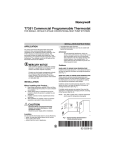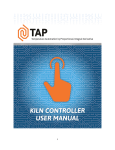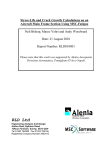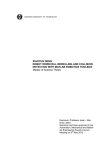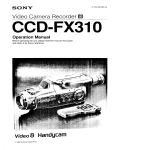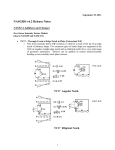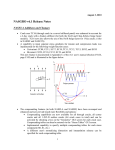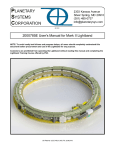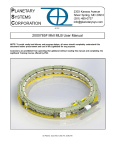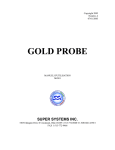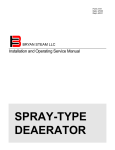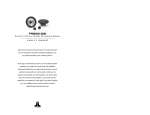Download NASGRO v7.1 Release Notes
Transcript
July 2, 2014
NASGRO v7.1 Release Notes
New Stress Intensity Factor Models:
•
CC16 - Single Corner Crack(s) at an Offset Hole in a Plate
Based on Fawaz-Andersson solution for remote tension, out-of-plane bending, and pin loads. It
has improved accuracy and a wider geometry range compared to CC02, CC04 and CC07 and is
consistent with the new CC17 solution for two unequal corner cracks.
•
CC17 - Two Unequal Corner Cracks at an Offset Hole in a Plate
Based on Fawaz-Andersson solution for remote tension, out-of-plane bending, and pin load.
•
SC30 – Semi-Elliptical Surface Crack (Offset) in Plate – Univariant WF
SC30 is a new crack case with the same geometry and stress gradient capabilities as SC17.
Compared with SC17, SC30 provides improved solutions for small crack aspect ratios (a/c < 1)
with longer gauge section length, which is consistent with conventional surface crack solutions.
SC17 and SC30 are identical for a/c ≥ 1.
•
SC31 – Semi-Elliptical Surface Crack (Offset) in Plate – Bivariant WF
SC31 is a new crack case with the same geometry and stress gradient capabilities as SC19.
Compared with SC19, SC31 provides improved solutions for small crack aspect ratios (a/c < 1)
with longer gauge section length, which is consistent with conventional surface crack solutions.
SC19 and SC31 are identical for a/c ≥ 1.
•
TC24 – Through Crack at Center of Plate – Displacement Control
Developed by ESA/NLR, TC24 is a counterpart of TC14. It represents a center cracked panel
subjected to displacement-controlled loading at the remote ends. The remote displacement
1
gradient is user-specified but is required to be symmetric due to the center crack configuration.
Not yet implemented in NASCCS or NASGLS.
Transition Capabilities for CC17:
•
The new stress intensity factor model (CC17) for two unequal corner cracks at an offset hole in a
plate described above will transition to a new hybrid model, HC01, a corner crack and a through
crack at an offset hole in a finite plate subjected to remote tension (S0) and pin load (S3), and
then transition again to TC23 (two unequal through cracks at an offset hole). CC17 can also
transition to TC23 directly, although this is a less likely occurrence.
•
The new HC01 model is currently only available as a transition model from CC17. The geometry
of HC01 is shown below; additional details are provided in Appendix C of the User’s Manual.
2
New Alternative Threshold Model:
•
A new, optional, alternative expression for threshold, with a new fanning exponent, Fth, was
introduced in v7.1b to overcome certain difficulties. It was observed that use of the present
threshold expression in which Cthp is set to the NASFLA default of 0, after having been fitted
originally with Cthp > 0 in NASMAT, causes not only the threshold regions of low-R crack growth
curves to be shifted leftward (or decrease) as expected, but the threshold regions of high-R curves
to be shifted leftward as well. The alternative threshold expression introduced in v7.1b is free of
this problem and is shown below:
•
The current threshold model using Cth is the default once a material is selected in NASFLA on the
Material screen. The user can choose the new alternative expression for threshold by clicking on
Fth in the box labeled “Threshold fanning exponent” in the GUI as illustrated below:
•
Note that when the new Fth threshold fanning exponent is selected, the labels for the threshold
parameter cells change to reflect the use of this new model.
3
New NASFLA Material Database Format:
•
All NASFLA material files have been converted one-for-one to XML-format counterparts (e.g.
NASMFC NASMFC.XMLZ, USRMFM USRMFM.XML, etc.); NASFLA now loads these
XML files instead of the pre-v7.1 format files.
•
Migration of user data files from older installations to the current installation will now include
conversion to XML for pre-v7.1 user material files. In addition, the NASGRO GUI "Migrate"
button now offers an option to convert-in-place (but not copy) individual pre-v7.1 user material
files (see Help in the User Data Files Migration Utility).
Improved NASFLA Capabilities for Multiple-Temperature Analyses:
•
On-screen editing of material parameter values has now been extended to multi-temperature
material file entries.
•
Implemented the capabilities of user-specified unique limit stress temperature in multipletemperature fatigue life analysis.
•
New failure criteria enabled with temperature effects: The enabled new failure criteria now will
check the following and work accordingly:
o Temperature dependent properties
o Tension/compression or t1/t2 stress gradients
o Limit stress with t1/t2 and temperature dependency
•
When loading an input file for single-temperature materials, the GUI will now compare the
values of the material parameters stored in the input file with the values in the material file for the
loaded ID. If any value differs, a notification will be displayed, allowing the user to choose to
retain the loaded input file values, or to use the material file values, for the analysis. For batch
mode (running multiple input files at once), a new message dialog is presented at the start of the
run, to present the user with this choice: "Use input files values" or "Use material file values" can
be chosen, and this decision will be applied to all input files in the run that contain these
differences.
4
New NASFLA GUI Features:
•
The "Enter ID code directly" button on NAFLA GUI material input page has been relabelled to
"Search material database." Button's search functionality now includes IDs (as before) as well as
any material entry's text description field (using a search string of at least 3-characters). From the
search results list, any single entry matching the search term can be loaded into the material input
page for use in analysis or be examined graphically, or any pair of entries matching the search
term can be compared graphically. The "drill-down" method of searching through categories,
alloy groups, etc, of prior NASGRO versions is also still available by clicking on “Show
materials list.”
5
•
A new checkbox for SIF Compouding has been added: "Do NOT Continue After Transition", for
users to make a forced choice as to whether or not to continue compounding after transition (for
those crack cases that have SIF compounding and where post-transition compounding is offered).
Previously, there was only the "Continue after transition" checkbox whose unchecked state meant
'do not continue' but could have been left unknowingly unchecked. Now, with two mutually
exclusive checkboxes, the user will be cognizant of the choice made.
•
Implemented two more options for user-specified toughness capabilities, i.e. user-defined Kc
values by crack tip class and constant Kc value.
6
Known Issues in v7.1
Saving New Data to User Material Files. The entire NASFLA material data base has been converted to
an XML-format as discussed above. However, in v7.1, when specifying a user-defined material in
NASFLA as “New Data” it is not yet possible to save a user-defined material into the new XML-format
files (e.g., USRMFC, USRMFM, etc.) and the checkbox to do this on the Material screen in NASFLA is
grayed-out. As a work-around, it is recommended that the user employ NASGRO v7.01 (or earlier) to
save the user-defined material data in the old file format and then use the v7.1 “Migrate User Data” utility
available on the NASGRO opening screen to convert the user material files to the new v7.1 XML format.
An alternative work-around would be to use an XML editor (or a plain text editor) to edit the v7.1 XMLformat user files directly. Please consult Appendix E for more information on the new material file
format. A future version of NASGRO will have the capability to save user-defined material data to the
XML-format database.
Post-Transition Crack Tip Output in Out2 File. When multi-degree-of-freedom (MDOF) crack models
having two or more crack tips automatically transition to other crack cases, the printed crack lengths in
the out2 file can sometimes be difficult to interpret. This is because the out2 file is printed based on the
crack-tip labels of the pre-transition crack case. After transition, when the type and number of crack tips
has changed, data may be printed in the wrong columns (or mislabeled) because the numbers of data
columns before and after transition do not match (but all the data are, in fact, printed). The real
“problem” is that the crack tip nomenclature genuinely changes from crack case to crack case, and it is
difficult to anticipate in advance what kind of transition will occur. This is a common problem that has
existed for some time in earlier versions of NASGRO and it is not specific to any particular crack case.
At present, the user needs to carefully examine the post-transition crack lengths in order to be clear in the
interpretation of the results. The NASGRO development team is investigating solutions to this
complicated output issue.
Net Section Yield (NSY) Residual Strength Calculation for Weight Function (WF) Models. The NSY
residual strength calculations (plots) for WF models are incorrect when one or more stress gradients are
input. The NSY failure mode calculation for WF models is correct during the NASFLA crack growth
analyses. The WF model Gi (G-factors) printed in the out2 file are incorrect since they are computed for
remote or uniform/constant loadings and not the input stress gradients; they are only used in plotting the
residual strength NSY curve. At present, the approach to take (for a WF model residual strength analysis)
would be to use the Limit Stress option on the Load Blocks page and specify the peak stress of the
gradient for each applicable stress component. The NASGRO development team is investigating
solutions to this issue.
Additions (NASFLA):
•
Crack growth constants for the following materials were added to the materials files:
o
o
o
o
o
o
o
o
o
B2IB18AB1
B2IB18AB8
B2IBA1AB1
B2IBA7AB1
B3GE28AC1
E2FB11AB8
E2FB13AB1
M2UA31AB1
M2UA32AB1
A225 Grd B PLT; L-C; Lab air; RT
A225 Grd B PLT; L-C; Lab air; -20F
A225 Grd B Weld; RT
A225 Grd B (Weld) HAZ; RT
A372 Cls V Forging; L-C; Dry air; RT
AOS 1146A PLT; L-T; Lab air; -20F
AOS 1146A PLT; L-T & T-L; Lab air; RT
2099-T83 Extrusion; L-T; Lab air; RT
2099-T83 Extrusion; T-L; Lab air; RT
7
Addition (NASSIF):
•
•
Implemented crack case CC17.
The capability for the user to provide a problem title and a description is now provided. These
descriptions are copied to the output file for display and printing.
Additions (NASMAT):
•
Added the following material IDs to the database:
o B3GE28AB01A: A372 Steel FORG, L-C
o M2EA11AB01M: 2024-T3 Aluminum 0.25” PLT; L-T
o M2EA12AB01C: 2024-T3 Aluminum 0.25” PLT; T-L
o M2EF11AB01B: 2024-T42 Aluminum 0.125” SHT; L-T
o M2EF12AB01A: 2024-T42 Aluminum 0.125” SHT; T-L
o M2UA31AB01A: 2099-T83 Al-Li EXTR; L-T
o M2RA11AB01C: 2198-T8 Aluminum 0.25” PLT; L-T
o M2RA12AB01C: 2198-T8 Aluminum 0.25” PLT; T-L
o M2RA13AB01B: 2198-T8 Aluminum 0.25” PLT; TL45
o M7TF11AB01U: 7475-T7351 Aluminum 3” PLT; L-T
o M7TF12AB01E: 7475-T7351 Aluminum 3” PLT; T-L
•
Added the following material IDs to the fatigue crack growth and toughness database:
o B2IBA1AB01A: A225 Grd B Weld; L-C; RT
o B2IBA7AB01A: A225 Grd B (Weld) HAZ; L-C; RT
o B2IB18AB01A: A225 Grd B; PLT; L-C; RT
o B2IB18AB01B: A225 Grd B; PLT; L-C; RT
o B2IB18AB01C: A225 Grd B; PLT; L-C; RT
o B2IB18AB08A: A225 Grd B; PLT; L-C; -20F
o E2FB11AB08A: AOS1146A; PLT; L-T; -20F
o E2FB12AB01A: AOS1146A; PLT; T-L; RT
o E2FB12AB01B: AOS1146A; PLT; L-T; RT
o E2FB12AB01C: AOS1146A; PLT; T-L; RT
•
NASMAT now allows users to specify plot limits when plotting raw material data.
Changes: (NASFLA):
•
Crack case SC08: added Eddy Current to available NDE methods.
•
The threshold value of Smax/Flow stress is now read from the materials file and displayed,
allowing the user to modify its value if the user wishes. This can be done for both singletemperature and multi-temperature cases.
•
Crack growth constants for the following materials were modified in the materials files:
o E4EB29AB1 Pyrowear 52; 5” Rnd Bar; R-L; Lab air; RT
o E4EB29AC1 Pyrowear 52; 5” Rnd Bar; R-L; Dry air; RT
o M7TF12AB1 7475-T7351 PLT; T-L; Lab air; RT
8
•
Re-enabled the "New Data" Data Source on the Material tab.
•
Crack case BE03: applied the beta factor correction in calculation of stress intensity factor range
for a-tip and c-tip.
•
Pre-v7.1 user material files that were migrated and converted to XML now allow using the same
sequence of alphanumeric characters to represent different combinations of product form /
environment / orientation in their material ID.
•
Removed the following controls from the NASFLA GUI for elastic-plastic mode only:
o "Show list of frequently used schedules" and "Add schedule to frequently-used list"
buttons on the Build Schedule tab, since these were already non-functional;
o "Compute cycles to specific crack sizes" checkbox on the Ouput Options tab, a feature
for linear-elastic mode only;
o "View Output Summary" button on the Computations tab, which was not needed since
the output window is already populated automatically upon completion of calculations.
•
XML material files: Ramberg-Osgood tags no longer nested in separate RambergOsgood
grouping.
•
XML material files: Alternative Failure Criteria tags no longer nested in separate
AltFailureCriteria grouping.
•
Crack case CC17: Simplified the limits expressions in the bitmap image.
Change: (NASSIF):
•
Crack cases SS02, SS03, SS04, SS05, SS06, SS12: the output files for these standard specimen
cases now contain the value of the pin load P in addition to the mean bearing traction applied by
P to the specimen.
•
Crack case CC17: Simplified the limits expressions in the bitmap image.
Changes (NASFLA, NASSIF, NASCCS):
•
Crack case TC23 – Two unequal through craks at offset hole:
o Extended the solution to handle B > W/2 and/or b > W/2, where "B" is the distance from
the hole center to the plate edge, and "b" is the distance from the center of the overall
flaw (tip-to-tip crack) to the plate edge, and "W" is the width of the plate.
o Provided the two pin load options for the crack case, i.e. compression clipping and full
range.
•
For HC01:
o The lower c/c1 limit is extended from 0.1 down to 0.01, and Appendix C updated
accordingly.
o The stress intensity factors at c1-tip are multiplied by a factor 1.05 to better calibrate the
FEA benchmarks.
•
Crack case TC23: The bitmap image has been reversed horizontally.
9
Changes (NASFLA, NASSIF, NASCCS, NASGLS):
•
Removed the following "Reserved for future use" crack case menu selections: CC06, EC03,
SC16.
•
Informative popup messages added to the following crack cases: CC02, CC04, CC07, CC16,
SC17, SC19.
•
For batch mode analyses using “Create batchfiles only” mode, batchfiles (formerly written to the
single directory “MultipleFilesBatchDirectory” in the data files installation path) will now be
created in the directory in which the input files are located.
Change (NASFLA, NASCCS):
•
Crack cases CC08, CC10: The surface correction factors ‘β’ have been enabled and applied to
both surface crack tips.
Changes (NASMAT):
•
The plot dialog has been redesigned to allow changing the plot label and the X/Y ranges from the
dialog box once a fit has been performed. The ability to manipulate the X and Y ranges is not
enabled for plotting only the raw data.
•
Saving user fits to the user file for NASFLA (usrmfc.xml and usrmfm.xml) has been changed to
handle the new XML format.
•
When saving R-value data to file through the Enter/Edit dialog, NASMAT will now
automatically suggest a file name based on the material ID and generate a prompt for the user if
the file already exists.
•
On the Curvefit/Plot tab the plot range text boxes have been reordered. The X minimum and
maximum boxes are now grouped together, as are the Y minimum and maximum boxes.
•
Saving fits to NASFLA, NASMAT no longer inserts bracketed ID's into the material description
fields.
Change (NASFORM):
•
Wordpad has been removed from the Windows default path as of Windows 7 and can no longer
be called from NASFORM. As such, Wordpad has been removed from the NASFORM menu.
Change (User Data Migrator / Converter):
•
Bracketed ID data is no longer written to the beginning of the material description tags during file
conversion.
10
Changes (Configuration Control):
•
Updated to include new crack cases, new Fth-related threshold parameters.
•
Readability improvements in the “available” and “unavailable” crack case lists
Compiler Changes:
•
NASBEM and NASFORM have been recompiled under Visual Studio 2008.
Fixes (NASFLA):
•
Crack case SC19: when transitioning to crack case TC11, the transition message that was issued
was confusing. The crack tip labeling for TC11 has been changed to be consistent with the
surface tip designation used for SC19.
•
An internal memory problem caused the selections for the "Load interaction model" radiobox to
somteimes become blank.
•
Crack case SC06: solution was modified to better match NASSIF. Previously, NASFLA
calculated much smaller stress intensity factors than NASSIF for short cracks. (Differences exist
between NASFLA and NASSIF for SC06 due to solution speed considerations in NASFLA.)
•
Missing drivers and font files caused the material plot of the "Compare Two IDs" feature to
contain no text.
•
Crack case SC17: an input deck causes GUI to terminate the computations with no results. The
error was a result of a symmetric SC17 transitioning into a symmetric TC11 where printing the
Kr result for new failure criteria was requested.
•
Crack case TC15: an analysis resulted in the error "[ERROR.TC15_all]: x-coordinates need to
end with t!." A compiler issue was identified where a number restored by multiplication after
division was not identical to its original value with a very minute difference.
•
Crack case SC17: fixed the crashing problem with t1/t2 capabilities turned on.
•
Incorrect batchfile contents regarding the stress gradients for limit stress flags prevented an
analysis from running.
•
Crack case SC17: a computation with t1/t2 feature and only limit stress check in first load block
completed with an error. This was a result of variables not being initialized properly.
•
Internal coding error prevented the plotting of 1D tabular data.
•
IDs for several NASGRO multi-temperature material file entries were corrected to properly
reflect the temperature in the temperature portion of the ID:
o M5BA12LA2.A0013 corrected to M5BA12LA2.A0008
o P3EM23LA2.A0037 corrected to P3EM23LA2.A0008
11
o
o
o
o
o
o
F3KA13LA2.A0007 corrected to F3KA13LA2.A0008
F3KA50LA2.B0007 corrected to F3KA50LA2.B0008; description changed from "AISI
316/316L Cast; -453F/-269C LHe" to "AISI 316/316L Cast; -452F/-269C LHe"
G7AA13LA2.A0007 corrected to G7AA13LA2.A0008
G7CA13LA2.A0007 corrected to G7CA13LA2.A0008
M5BA12LA2.A0013 corrected to M5BA12LA2.A0008
P3EM23LA2.A0007 corrected to P3EM23LA2.A0008; description changed from "Ti6Al-4V (ELI); RA(1700F/927C/4h) Forg; -453F/-269C LHe" to "Ti-6Al-4V (ELI);
RA(1700F/927C/4h) Forg; -452F/-269C LHe"
•
Descriptions for several NASGRO material file entries were corrected to properly reflect the
temperature:
o F3KA50LA2: from "AISI 316/316L Cast; -453F/-269C LHe" to "AISI 316/316L Cast; 452F/-269C LHe"
o P3EM23LA2: from "Ti-6Al-4V (ELI); RA(1700F/927C/4h) Forg; -453F/-269C LHe” to
"Ti-6Al-4V (ELI); RA(1700F/927C/4h) Forg; -452F/-269C LHe"
•
NASGRO material file entry M2EI11AB1: typo in value for q was corrected from ".0.5" to "0.5".
•
Crack case TC23: could not enter data for "Set Crack Size Limits" option.
•
Crack case TC23: blocked transition to crack case TC19 if the B/R ratio is larger than 24.
•
Plot titles for saved material data plot images of types .cgm and .png were missing.
•
An internal string conversion error prevented plotting of alternative 2D stress input data.
•
An internal string conversion error caused the data file for the exceedance plots for S0 for an
edited spectrum to erroneously contain hex values, preventing the plotting.
•
Crack cases CC02, CC04, CC08: fixed the crashing problem when post-transition compounding
is enabled.
•
When mutliple spectrum load blocks are defined, their default block types were "predefined
block", but should be "manual".
•
Copying material data from Excel to the Clipboard then into the 2D material data table caused
some data to be copied to the wrong columns in the material table, for rows containing empty
leading cells. For these rows, the GUI was not recognizing the placeholders for thee empty cells.
•
Alloy group descriptions were corrected in NASMFC.XMLZ, NASMFM.XMLZ, Appendix G,
and NASMAT's identify.dat file to show the correct MA(1450F/788C/0.5hr) heat treatment for
ID P3EA13AB1.
•
An internal string conversion error prevented plotting of bi-variant stress data.
•
The Walker equation material constant values of DK0, Rcut+, A, and Rcut- were not being saved
to input file.
•
Linear temperature interpolation problems with user material file.
12
•
NASFLA-NASMAT liaison file fitinfo.dat: NASMAT dataset ID B5BFC2AB01B1 removed
from the list of datasets to plot for the basic fit for NASFLA material B5BFC2AB1; dataset had
been erroneously included in an earlier release.
•
NASFLA-NASMAT liaison file fitinfo.dat: duplicate (and sometimes conflicting) entries for
NASFLA IDs M7HK11AB1, P3EDB2AA1, P3EDB2AB1, and Q7AD13AB1 removed;
NASFLA will now show correct information for comparison plots and references.
•
For plotting tension and compression stress gradients, an incorrect scriptfile command caused the
compression gradient plot to disappear immediately from screen, implying this plot was not being
generated.
•
Crack case SC17: A file handling/sharing problem prevented the anaysis from running for the
crack transition to CC11 then to TC12.
•
The "Scale factors" grid associated with the "Do parameter anayses" grid on the Computations
tab was incorrectly located too far right on the GUI page, preventing it from being seen.
•
Using Chang Willenborg crack growth model caused the stand-alone code to crash, due to two
uninitialized variables.
•
Batchfile content error for reverse calculation analysis in some instances prevented the analysis
from running. This would happen if the "compute cycles to intermediate crack size" checkbox
was checked in "calculate crack growth" mode, then the mode is changed to "calculate initial flaw
size given target life" (reverse calculation mode).
•
For the "Generalized Willenborg" load inteaction model, the "Select Willenborg Model" radiobox
was always being set to the first choice, preventing the second choice and its associated
"Parameter Ph0" value from being selected/entered or saved to inpuf file.
•
Internal buffers that were not cleared caused some stress grids to be erroneously shown onscreen.
•
Loading an input file with only saved material data caused a Configuration Control error message
regarding the crack case being loaded, even if no configuration control restrictions were in place.
Additionally, the material data was not loaded.
•
Crack case TC23: The option to continue compounding after transition has been enabled.
•
Numeric validation of the contents of the 1D table containing threshold parameters has been
corrected to properly flag non-numeric entries.
•
Included missing title lines, and increased width of plot area image when viewing material Basic
and Comparison fits, and changed the format of the displayed material parameters and their
values to be a two-column display, for better readability and to avoid some of these labels from
crossing the right edge of the plot.
13
•
Crack cases SC09, SC10: corrected multiplication error in the formula for converting between US
and metric units for calculating initial crack depth when using a bolt size of “Other” and the
"NASA std NDE" initial flaw size option.
•
Corrected legend for F1(a) for post-processing plot of beta factors, which incorrectly read
"F0(a)".
•
Unchecking the "Suppress closure" checkbox did not re-display the material parameter
"Smax/Flow".
•
Crack case SC27: If crack case TC15 was previously selected, then crack case SC27, the "Set
crack size limits" checkbox was misplaced on-screen, and would overlap the Geometry Grid.
•
For the "Compare Two IDs" button, whole number values of some material parameters were
being incorrectly interpreted by the plotting program as integers, resulting in incorrectly
calculated values and preventing the plot.
•
Plots using the "Compare Two IDs" button of a material description containing a double-quote (")
failed due to incorrect creation of the plot scriptfile.
•
Crack cases CC16, CC17: corrected a problem in plastic zone size calculation to make the two
crack cases work with the Willenborg retardation models.
•
A problem with truncation of alloy descriptions when reading the user's material file was fixed in
the out1 output file displayed in the GUI output window after calculations are complete.
•
The material description, as displayed on the Material tab just above the material parameter text
boxes was excessively truncated and was not using all the available screen width. This has been
extended to use the entire screen width to display as much of the material description as possible
(in most cases, the description is displayed in its entirety) .
•
Crack case SC19: error produced using S0, S1 and RS stress gradients. A compiler issue was
identified where closed files (having been assigned negative file IDs) triggered the error. The
related routines have been modified to fix this problem.
•
Crack case SC30: The symmetrical crack configuration was not working with the strip yield load
interaction model. The current strip yield load interaction model can support up to two crack tips
and in this case, this load interaction model should remain applicable. The error was identified
due to a bug that didn't include SC30 as one of the valid crack models for strip yield model. The
strip yield routines have been updated to include this new crack case.
•
Enabling Keac check for multiple temperature applications resulted in immediate failure even
when the computed SIF was smaller than the specified Keac. The root cause was because the
Keac specification was only initialized with the first temperature while the Keac values with the
rest of the temperatures were not. Assigning the provided Keac value to the rest of the
temperatures resolves the bug.
•
Analyses using 2D tabular material data could not be run. This was caused by an internal storage
array being too small for the data that is loaded from input file. The GUI input file now stores the
entire material record in XML format. The array size used to read this very long string was
14
increased in 7.10 alpha from 1000 to 15,000 characters; however, for some very large tabular
data, the new size limit was still exceeded, and so was raised again, to 100,000.
•
Crack case TC16: An additional run-time edit check has been added: "µ", a measure of the
stiffener stiffness relative to the sheet stiffness, where µ = As*Es/(As*Es+L*t*E), must be within
the range: [0.1 ... 0.5].
•
The Load interaction model radiobox was inadvertently shown in the NASFLA GUI in elasticplastic mode and has been removed.
•
The "Bypass NSS" checkbox was inadvertently shown in the NASFLA GUI for elastic-plastic
mode.
•
Crack case TC17: different result obtained using the standalone code with instability check at
limit stress. The NASGRO GUI predicted immediate failure due to K(limit) larger than Kc while
the standalone predicted the computed K exceeded Keac at 182,563 cycles. The inconsistency
was due to a bug in the program that was picked up by the compiler used to generate the standalone code resulting in very large negative K(limit) value. The related routine was modified to
resolve this.
•
Crack Case CC16: an incorrect geometry error was issued for the "two symmetric cracks"
configuration.
•
The material parameter "Threshold Smax/Flow" was not being saved to, nor loaded from input
file.
•
On the Load Blocks tab, the screen label for entering limit stress (seen after checking the "Check
throughout this block for crack instability and net-section failure at limit stress?” checkbox) was
corrected to be: "Scale factor(s) for limit stresses:" for the following crack cases and crack plane
stress definitions:
o SC17 Polynomial;
o SC17 User input, Crack Plane;
o SC30 Polynomial;
o SC30 User Input, Crack plane;
o EC02 User Input, Crack plane;
o EC04 Polynomial;
o EC04 User input;
o EC05 User input, Crack plane;
•
The expression upper limit for a/t was changed from 0.9 to 0.95 for the following crack cases:
SC17, SC19, SC30, SC31.
•
The second title line of the plot showing a material’s “Basic fit” has been corrected to show the
complete "Detailed description" of the material, which includes the alloy description.
•
When displaying entries from metric multi-temperature materials files, values displayed in the
"View temperature:" dropdown box were incorrect (for both values displayed, F and C). The
program reads a single temperature value from file (in F or C, depending on which Units selected
in the options), but then incorrectly calculated the values to display.
15
•
The four material parameters Alpha, Smax/Flow, Threshold Alpha, and Threshold Smax/Flow,
were editable in the NASFLA GUI, but their edited values were not written to the batch file.
•
Reinstated IDs P3EMD2AB1, P3EMD2LA4, P3EMD8AB1, P3EMD8LA4 (were removed in
v601 and v610 due to digitizing and fitting errors).
•
On the “Material” tab, the Material Parameters label would not retain the value “The parameter
values shown have been changed from their original material file values” when changing between
temperature values in multi-temperature data.
•
Crack case CC17: data column "a1/c1" was added to the out2 file and the NASFLA GUI was
expanded to view and plot this data.
•
Crack case CC17: If the analysis transitioned to HC01, an error message was issued when
viewing output details, stating this crack case was not recognized.
•
Crack cases BE02,03, CC17, EC02,04,05, SC17,18,19,26,27,28,30,31, TC11,23: When viewing
the output, column headers for Beta Factors, F for crack tips tips a1 and c1 were missing.
•
Saving plots to text files from the Plot Dialog caused a crash.
•
Crack case TC18: A Fortran error code “5” occurred when running TC18 with two symmetric
cracks. It was caused by an incorrect implementation that restricted the number of stress
quantities.
•
The Curvefit views radiobox was inadvertently displayed when changing the "Temperature to
view:" listbox, for user multi-temperature material data.
•
During computations using User 2D tabular material data, the NASFLA GUI briefly changed the
selected tab from ”Computations” to “Material”, then back to “Computations”.
•
When visualizing the GSFC spectrum on the “Load Blocks” tab, the “Using stress level
histograms” radiobox option did not plot.
•
Switching between elasticity types did not clear all controls from the “Material” tab.
•
Full cyclic shakedown analysis fails to complete with Fortran error code. A bug was identified in
cyclic shakedown routines when to retrieve the elastic stress state from the backup file.
•
NASFLA did not generate a plot for da/dN in cases where da1/dN existed in the out2 file.
•
NASFLA did not disable Advanced Spectrum Editing when using multi-temperature data or
incompatible load interaction models. Furthermore, when switching from Strip Yield to an
16
incompatible interaction model or switching to multi-temperature data when Advanced Spectrum
Editing was already selected, NASLFA did not disable ASE in existing load blocks.
•
NASFLA did not perform validation for the Threshold Material parameters ”Alpha” and
“Smax/Flow”.
•
Crack case SC27: Incorrect “symmetry” flag was written to batchfile, preventing the run.
•
Crack case SC26: User-provided NASFLA input deck crashes the stand-alone NASFLA code. An
error was identified in the designation of offset when invoking the SC17 SIF routine from SC26
crack module.
•
Crack case SC28: Computations failed due to an error in the designation of offset in SC28 crack
module.
•
Crack cases SC26, SC27, SC28: Corrected the features “Set Crack Size Limits” (on Geometry
tab) and “Compute cycles to specific crack sizes” (on output Options tab) to show additional
crack tip ‘a1’ (previously never shown) for non-symmetric crack conditions.
•
Material parameter fields were populated with incorrect internal record data (“garbage”) if that
field’s tag data was missing from the material file. Now, if there is no tag data in the file for that
field, the GUI input field will be blank.
•
Attempting to save plots to CGM, Postscript, GIF or PNG files did not generate an output file.
•
The “Fth value used in analysis” radiobox on the “Material” tab did not reset to “0 throughout”
from “0 initially” for 3D or 4D crack cases.
•
When plotting t1/t2 stress gradients on the “Geometry” tab, the plot dialog window was
incorrectly titled as if tension/compression stresses were plotted.
•
On the “Material” tab, with the “New Data” data source chosen, changing between load
interaction models caused GUI elements to be placed incorrectly.
•
When loading a DT02 input file, the D2 field on the “Geometry Tables” was populated with the
D1 value from the input file.
•
When running multiple input files in batch mode, selecting “Use material database values” when
one or more of the input files contained ‘new data’ as a data source caused a crash.
•
Material parameter “DK1f” was corrected in the NASA metric unit XML material files:
nasmfm.xmlz, nasmtm.xmlz. Previously these values were erroneously in US units.
17
•
When running a multi-temperature analysis in NASFLA, values of zero for KIc, Ak & Bk are
shown for the first material in the out1 file.
•
Crack case TC18: Corrected “Compute cycles to specific crack sizes”, which didn’t work for this
crack case.
•
When “Comparing two IDs”, one of the two selected IDs would not be loaded correctly for
comparison if a material was already previously loaded into the material input tab.
•
The plot for Comparing two IDs inadvertently displayed K1e for K1c.
•
A “flagui.exe 32” process remained in memory after the GUI was closed.
•
Crack case CC17:
o Provided output of crack aspect ratio (a1/c1) in the out2 file.
o Modified output format of the initial flaw sizes in the out1 file to print a, c, a/c, a1, c1,
and a1/c1.
o Fixed an error in geometry limit check for TC23-TC19 transition at c1-tip, i.e. (WB)/R<=24.
•
Crack case SC08: Incorrect value for “initial flaw size, c” in Geometry Grid when “Initial flaw
option” is set to “NASA std NDE” using NDE Type: Eddy current.
Fixes (NASSIF):
•
Crack case TC05: corrected the output heading for "F4" in the NASSIF output file, which was
mislabeled "F2".
•
Crack case TC11: hangs resulting from a specific stress gradient used for NASSIF. A bug was
identified in OPS routines where one of the iterations was stuck in an indefinite loop. This root
cause had been identified and resolved. The same fix has also been applied to the OPS utility
program for NASGRO GUI.
•
Crack case TC11: unmatched column output in OUT1 file for four stress quantities in NASSIF
analysis. The output format for the fourth stress quantity was incorrectly specified.
•
Crack case SC04: Changing the "internal pressure" field did not prompt the user to resave the
input file.
•
Crack case SC17: incorrect geometry checking code issued a false error for some valid input.
•
Crack case TC11: Crack tip labels for TC11 in NASSIF were made consistent with the updates
for crack tip designations from (a,c) to (c,c1) that were previously made in other modules.
•
A batchfile error during the plotting of the data tables for DT cases, stress plotting of SC cases,
and SIF compounding table data prevented the plots.
18
•
The upper limit for a/t was changed from 0.9 to 0.95 for the following crack cases:
o SC17, SC30, SC31.
•
Invalid a, c and a/c output occurred when results were requested for crack sizes larger than the
geometry limits. The problem was identified because of the change in crack tip designation that
resulted when a too large crack triggered a transition. A fix to retain the original crack sizes
resolved the issue.
•
Crack case CC17: Fixed a problem to make NASSIF run for CC17 with a/c equal to 0.2 (the
lower limit).
•
Crack case CC17: when selecting a fixed corner crack on the Output Options tab, the labels of the
controls for entering data for the other crack were incorrect (a/c, flaw sizes a, auto-fill a/c, autofill a).
•
Saving plots to text files from the “Computations” tab triggered a crash.
•
Crack case TC18: Inconsistent output for user-provided stresses. The load description indicated
remote tension and bending while the input deck contained users-provided stress gradients
defined along the crack plane. The inconsistency was a result of incorrect output flag in
implementation.
•
Crack case CC14: “Initial flaw size, a” was erroneously being shown in the Geometry Grid,
causing the entry to be required, and prevented the analysis from running.
•
The category list for Embedded Cracks contained an extraneous blank line at the end.
Fixes (NASCCS):
•
Changing units setting would cause a GUI crash.
•
In batch mode for sequential analyses of crack cases SS19 and SS01, an incorrect error message
was displayed, suspending the batch run.
•
Crack case SC15: The error message “Solution invalid if a/c < 0.1 or a/c > 1.21” was erroneously
generated for valid values of a/c, preventing the run.
•
Crack cases SC30, SC31: The descriptions on the “Geometry” tab stated “semi-elliptical surface
crack at (offset) hole in plate” rather than “semi-elliptical surface crack (offset) in plate”.
Fixes (NASFLA, NASSIF):
•
Crack case TC11: An unspecified stress variation in full range for non-symmetrical crack case
resulted in misleading results. The new implementation now performs two checks for stress
gradients provided for the univariant crack models: CC08, CC11, CC13, CC14, CC15, EC02,
EC05, SC17, SC18, SC30, SC26, SC27, SC28, TC11, TC12, TC13, TC17, TC18, and TC19. One
is to ensure the normalized coordinates are in ascending order, and the other is to confirm the
stress points are given over the full range.
19
•
Crack case SC18: the limit on a/T of 0.8 was exceeded during fatigue crack growth calculation.
This limit has been extended to 0.9. The new limit is applied to both NASSIF and NASFLA
analyses for consistency. Similar changes are also applied to the CC10, CC14, SC18 and SC27
crack models.
•
A bad internal file path prevented the compounding data from a previous analysis run to be
viewed.
•
Crack case TC11: consistent crack tip labeling has been imposed such that the crack tips are
described by c- and c1-tips instead of a- and c-tips. This change is crucial to help clarify when
crack transition from SC17 to TC11 occurs where the old crack tip designations may confuse the
user by the changes of crack tips from c- and c1-tips of SC17 to a- and c-tips of TC11.
•
Crack case CC12: errors in SIF calculations were found in cases where a/c is slightly lower than
1. A bug was identified in the pre-integration tables for CC12. New tabulated routines have been
implemented to resolve this issue.
•
Crack case SC06: corrected a batchfile error preventing the plotting of stress gradient data.
•
Attempting to plot the SIF Compounding table data on the GeomTables tab would at times result
in various intermittent errors, including a GUI crash, DLL errors, and individual (instead of
combined) interpolated data plots, due to the GUI improperly indexing the various stress
quantities defined for the chosen crack case.
•
Changing the interpolation type for a SIF Compounding table would cause a GUI crash.
•
Crack case TC11: Incorrect indexing of crack tip SIF compounding tables led to a GUI-issued
error message stating some SIF tables were undefined.
•
For stress quantities S2 and S3, if two or more SIF compounding tables were defined and saved in
the input file, only the first one was being loaded.
•
Crack case SC26: an error in geometry grid indexing incorrectly determined 2D cracks to be 3D,
resulting in the SIF Compounding checkbox to be removed from the Geometry tab and an
erroneous batchfile, preventing the analysis from running.
•
Inconsistent SC17/SC19 and SC30/SC31 results for crack models subjected to simple remote
tension. Insufficient refinement in point spacing for generating reference solutions with smaller
a/c ratios was identified to be the root cause. Changing to more refined point spacing resolved the
inconsistency.
•
Steep stress gradient failed OPS algorithm. The steep stress gradient with maximum stress along
one single line appeared misleading the contour-based 2D OPS algorithm. A revision was made
to resolve this issue.
•
Crack case SC27: Incorrect symmetric flag written to batchfile was causing the DLL to crash
during analysis.
20
•
Crack cases SC26, SC27, SC28: Updated crack case bitmap images to show both crack tips 'a'
and 'a1'.
•
Memory leak identified by G95 compiled NASGRO static library. A batch job for verification
completed with warning indicating memory leaks when using NASGRO static library generated
by G95. A memory de-allocation bug was identified in the software module to determine stress
variations along the net section for embedded slots.
•
Crack case CC14: Incorrect batchfile was created when “Two symmetric cracks” was selected,
preventing the run.
•
Crack case CC02: When using 2D Compounding, on the GeomTables tab, the table selection
grids for stress quantities S1 and S3 were missing the yellow background color in the cell of the
number of the table being displayed.
•
Inconsistent SIF results from NASFLA and NASSIF analyses using SC26 GUI input decks.
Inconsistent references in stress quantity index were discovered for CC08, CC13, CC14, CC15,
CC18, SC26, SC27, SC28, TC13, TC17, TC18, and TC19 crack models that only had S0 and S2
definition with remote loading.
Fix (NASSIF, NASCCS):
•
Crack case SC13: GUI crash occurred when choosing "Other" for Bolt major and minor diameter,
then clicking the Run button.
Fix (NASFLA, NASSIF, NASCCS):
•
Crack case TC11: corrected a typo that caused incorrect results when calculating the net section
stress caused by limit stress.
•
Crack case CC10: The newly added limit (for version 7.10 alpha) of "0 <= a/t < 0.9" was
incorrectly added as "a/c", not "a/t".
•
Recast the code for calculating stress intensity factors of crack case SC06, making NASSIF and
NASFLA generate identical stress intensity factor results.
Fixes (NASCCS, NASGLS):
•
Crack case SC17: the upper limit for a/t was changed from 0.9 to 0.95.
Fixes (NASFLA, NASSIF, NASCCS, NASGLS):
•
Crack case DT03: data table labels for c-tip should be a/D1.
•
Crack cases DT01, DT02, DT03: Entering data in the geometry grid would erroneously gray out
the GeomTables tab.
21
•
Crack case DT03: plotting of the table data was being prevented.
•
An incorrect break point in the file multi-run process was created, causing an input file to be
flagged as containing bad input when it did not.
•
Using square brackets in the input file name would prevent output files from being corectly
copied back from the working direectory after an analysis was complete.
Fixes (NASMAT):
•
In the Enter da/dN Delta K tab adding new da/dN data for an R-value now saves correctly when
multiple R-values are defined.
•
When saving new da/dN data from the Enter da/dN Delta K tab to the user file, the new data
could overwrite previous da/dN values for unrelated entries in the user data file.
•
Saving data after pasting from the clipboard to the da/dN grid of the Enter da/dN Delta K tab
caused NASMAT to crash.
•
Altering the da/dN data on the Enter da/dN Delta K tab or on the Examine/Edit Data tab,
selecting a new R-value would erase any changes made to any other R-value's data set.
•
Pasting da/dN data from the clipboard would assign da/dN values to other R-values rather than
the selected R-value.
•
Saving multiple fits to both usrmfc.xml and usrmfm.xml could corrupt the UTS value in the
dialog after saving.
•
When saving fits to the NASFLA database in both usrmfc.xml and usrmfm.xml simultaneously,
the value of K1c could be converted between units and not converted back or properly emptied,
leaving an incorrect value of K1c that would appear in subsequent fits. The value has now been
properly cleared after saving.
•
Resolved a memory access violation triggered on exiting NASMAT. Error was previously
trapped as it did not affect execution of NASMAT.
•
When attempting to do a NASMAT fit that causes the NASMAT dll to crash, the busy cursor
icon would persist even after the dll had exited and NASMAT had issued the error and had
resumed normal program flow.
•
In the Enter/Edit data dialog, when selecting "Save all R-value data to file", NASMAT now
correctly loads the current save path or the relevant Datafiles directory as the default path, rather
than defaulting to C:\.
•
Multiple minor fixes and corrections were made to GUI elements including slight changes to
verbiage, moving some text to mouse-over text, small changes to element size or position in order
to correctly align elements or add in separators or borders between elements.
22
•
When viewing references, clicking the 'Sort by Name' or 'Sort by Number' buttons without first
selecting a set of references to view crashed NASMAT. A warning dialog will now be issued to
inform users to first select a reference if none has been selected before sorting.
•
When viewing the Recent Changes in NASMAT, some lines from the Changes.txt file were not
being displayed properly.
•
Lengthy filepaths to the NASMAT Datafiles directory would occasionally cause NASMAT to
display incorrect behavior or crash.
•
When saving fits to NASFLA, NASMAT would not properly fill the MatIDProdForm XML field
nor correctly handle reserved XML characters.
•
Corrected digitized data for IDs P3EMD2AB01A, P3EMD2LA04A, P3EMD8AB01A,
P3EMD8LA04A
•
The "C" value was erroneously truncated to a single decimal place when saving fits to the
NASFLA user material file.
•
The NASA material file ID’s E2FB12AB01A and E2FB12AB01C did not display R-values.
•
Deleting User material ID’s from the “Data Identification” tab via the right-click command
displayed erroneous warning messages about the NASA data files, did not fully delete the chosen
ID from the header and data files, and did not refresh the ID list after the delete.
•
When saving fits to the NASFLA user material file, the “Description0” tag (Legacy Material File
name) and the “Version” tag fields were empty, instead of containing "no legacy material file;
data added after adoption of XML" and the current NASMAT version number.
•
When fitting Dk0, Dk1 and Cth via the “Curvefit/Plot” tab, the Threshold Parameters plot
dialogue did not display the X and Y axis names (R and DKth) on the plot dialogue nor properly
set the default plot limits.
•
Entering data via the “Data Source” button on the “Enter da/dN Delta K” tab did not
automatically display the newly entered data on the “Enter da/dN Delta K” tab.
Fixes (NASGLS):
•
Corrected the Recent Changes list, removing the extraneous "Added:" banner which had no
associated items, and included the missing "Changed:" title, which did have associated items.
•
Crack case CC07: The NASGLS GUI contained incorrect values for the lower limits of the
solution validity expressions for 'a/c' and 'D/t' for a case with stress quantity 'S1' defined.
•
NASGLS DLL error when trying to run cases with "database input” material. The root causes
were twofold. One was a result of multiple uninitialized variables such that the stand-alone
23
wouldn’t work. The other was resulting from the dynamic file ID not being passed correctly. The
bug fix has resolved both issues.
Fixes (NASBEM):
•
When calculating midpoints for segments, NASBEM would calculate the incorrect point or
utilize an incorrect level of accuracy if snap values had been altered.
•
When creating a circular arc, NASBEM would not always calculate the arc properly, and at times
would utilize points from a previously drawn arc when drawing the arc segment.
•
When changing grid snap values, newly created points would snap to the wrong value or alter
previously selected points values.
•
When clearing and then creating a new problem, NASBEM would not place arc segments
correctly.
Fixes (Start Up):
•
The NASGRO license file will now be checked by all GUIs at start-up time (NASFLA, NASSIF,
NASCCS, NASGLS, NASMAT, NASBEM, and NASFORM), requiring the version listed in the
license file to match that of the GUI itself.
Fixes (User Data Migrator / Converter):
•
Data Migrator erroneously put “TRADE/COMMON NAME STL [E]” into "<file_description>
</file_description>" tag for User material files when converting pre-v7.1 files to XML.
•
User Data Migrator GUI would issue an error message and fail to start if no “nasgro.ini” file
existed from a NASGRO installation prior to 7.00 alpha.
•
When converting a pre-XML user file to XML format:
o Incorrect values for material parameters “DK1f”, “Fth”, and “Fth-” were being created.
o The metric value for ‘a0’ was added incorrectly as “0.00381”.
o For no data in the source file, the converter was incorrectly adding a closing record tag.
24
























